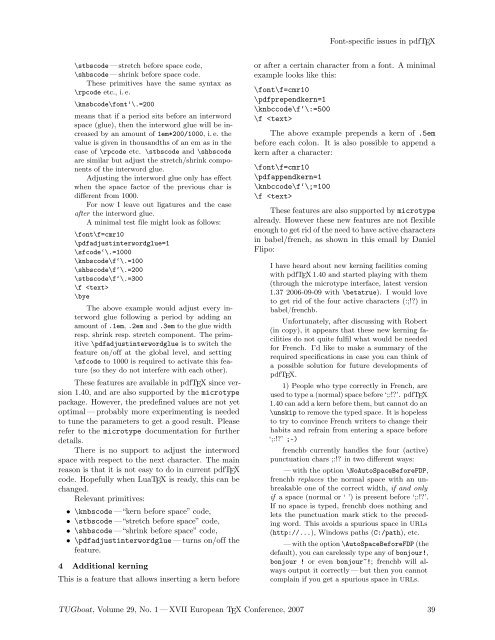Complete issue 29:1 as one pdf - TUG
Complete issue 29:1 as one pdf - TUG
Complete issue 29:1 as one pdf - TUG
Create successful ePaper yourself
Turn your PDF publications into a flip-book with our unique Google optimized e-Paper software.
Font-specific <strong>issue</strong>s in <strong>pdf</strong>TEX<br />
\stbscode — stretch before space code,<br />
\shbscode — shrink before space code.<br />
These primitives have the same syntax <strong>as</strong><br />
\rpcode etc., i. e.<br />
\knsbcode\font‘\.=200<br />
means that if a period sits before an interword<br />
space (glue), then the interword glue will be incre<strong>as</strong>ed<br />
by an amount of 1em*200/1000, i. e. the<br />
value is given in thousandths of an em <strong>as</strong> in the<br />
c<strong>as</strong>e of \rpcode etc. \stbscode and \shbscode<br />
are similar but adjust the stretch/shrink comp<strong>one</strong>nts<br />
of the interword glue.<br />
Adjusting the interword glue only h<strong>as</strong> effect<br />
when the space factor of the previous char is<br />
different from 1000.<br />
For now I leave out ligatures and the c<strong>as</strong>e<br />
after the interword glue.<br />
A minimal test file might look <strong>as</strong> follows:<br />
\font\f=cmr10<br />
\<strong>pdf</strong>adjustinterwordglue=1<br />
\sfcode‘\.=1000<br />
\knbscode\f‘\.=100<br />
\shbscode\f‘\.=200<br />
\stbscode\f‘\.=300<br />
\f <br />
\bye<br />
The above example would adjust every interword<br />
glue following a period by adding an<br />
amount of .1em, .2em and .3em to the glue width<br />
resp. shrink resp. stretch comp<strong>one</strong>nt. The primitive<br />
\<strong>pdf</strong>adjustinterwordglue is to switch the<br />
feature on/off at the global level, and setting<br />
\sfcode to 1000 is required to activate this feature<br />
(so they do not interfere with each other).<br />
These features are available in <strong>pdf</strong>TEX since version<br />
1.40, and are also supported by the microtype<br />
package. However, the predefined values are not yet<br />
optimal—probably more experimenting is needed<br />
to tune the parameters to get a good result. Ple<strong>as</strong>e<br />
refer to the microtype documentation for further<br />
details.<br />
There is no support to adjust the interword<br />
space with respect to the next character. The main<br />
re<strong>as</strong>on is that it is not e<strong>as</strong>y to do in current <strong>pdf</strong>TEX<br />
code. Hopefully when LuaTEX is ready, this can be<br />
changed.<br />
Relevant primitives:<br />
• \knbscode—“kern before space” code,<br />
• \stbscode—“stretch before space” code,<br />
• \shbscode—“shrink before space” code,<br />
• \<strong>pdf</strong>adjustinterwordglue—turns on/off the<br />
feature.<br />
4 Additional kerning<br />
This is a feature that allows inserting a kern before<br />
or after a certain character from a font. A minimal<br />
example looks like this:<br />
\font\f=cmr10<br />
\<strong>pdf</strong>prependkern=1<br />
\knbccode\f‘\:=500<br />
\f <br />
The above example prepends a kern of .5em<br />
before each colon. It is also possible to append a<br />
kern after a character:<br />
\font\f=cmr10<br />
\<strong>pdf</strong>appendkern=1<br />
\knbccode\f‘\;=100<br />
\f <br />
These features are also supported by microtype<br />
already. However these new features are not flexible<br />
enough to get rid of the need to have active characters<br />
in babel/french, <strong>as</strong> shown in this email by Daniel<br />
Flipo:<br />
I have heard about new kerning facilities coming<br />
with <strong>pdf</strong>TEX 1.40 and started playing with them<br />
(through the microtype interface, latest version<br />
1.37 2006-09-09 with \betatrue). I would love<br />
to get rid of the four active characters (:;!?) in<br />
babel/frenchb.<br />
Unfortunately, after discussing with Robert<br />
(in copy), it appears that these new kerning facilities<br />
do not quite fulfil what would be needed<br />
for French. I’d like to make a summary of the<br />
required specifications in c<strong>as</strong>e you can think of<br />
a possible solution for future developments of<br />
<strong>pdf</strong>TEX.<br />
1) People who type correctly in French, are<br />
used to type a (normal) space before ‘;:!?’. <strong>pdf</strong>TEX<br />
1.40 can add a kern before them, but cannot do an<br />
\unskip to remove the typed space. It is hopeless<br />
to try to convince French writers to change their<br />
habits and refrain from entering a space before<br />
‘;:!?’ ;-)<br />
frenchb currently handles the four (active)<br />
punctuation chars ;:!? in two different ways:<br />
—with the option \NoAutoSpaceBeforeFDP,<br />
frenchb replaces the normal space with an unbreakable<br />
<strong>one</strong> of the correct width, if and only<br />
if a space (normal or ‘ ’) is present before ‘;:!?’.<br />
If no space is typed, frenchb does nothing and<br />
lets the punctuation mark stick to the preceding<br />
word. This avoids a spurious space in URLs<br />
(http://...), Windows paths (C:/path), etc.<br />
— with the option\AutoSpaceBeforeFDP (the<br />
default), you can carelessly type any of bonjour!,<br />
bonjour ! or even bonjour~!; frenchb will always<br />
output it correctly—but then you cannot<br />
complain if you get a spurious space in URLs.<br />
<strong>TUG</strong>boat, Volume <strong>29</strong>, No. 1—XVII European TEX Conference, 2007 39

















